Home >Java >javaTutorial >JAVA process control is implemented in this way
JAVA process control is implemented in this way
- 王林forward
- 2023-05-15 10:34:051118browse

##Process control
JAVA input and output
Input
Two input methods:
Method 1: java.util.ScannerThe code is as follows:
public class a { public static void main(String[] args) { var sc = new Scanner(System.in); System.out.println("请输入姓名:"); String name = sc.nextLine(); System.out.printf("%n欢迎你:%s", name); }}
Generate a Scanner object, output "Please enter your name:", return the input string and assign it to name, and output "%nWelcome %s" where %n represents a newline and %s represents nameResult:
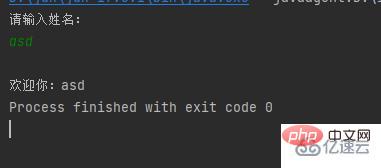
Method 2: JOptionPane If the input content is confirmed, the string value will be nullpublic class a {
public static void main(String[] args) {
String w = JOptionPane.showInputDialog("请输入词汇:");
System.out.println(w);
}}Result: 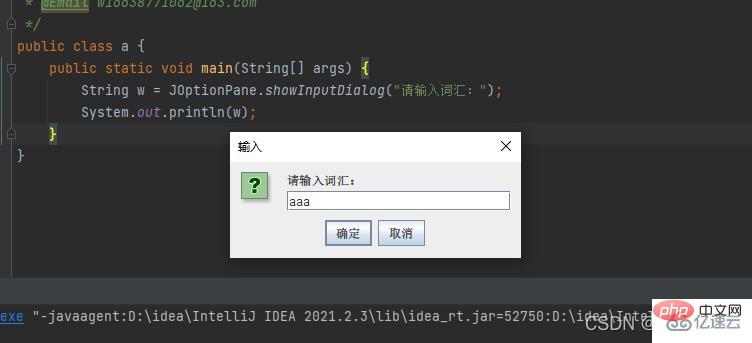

Three ways to output on the consoleMethod 1: System.out.print (); Output to the console
Method 2: System.out.println(); Output to the console and wrap
Method 3: System.out.printf(); Format the output to the console
Code demonstration:
The first method outputs directly without line breakspublic class a {
public static void main(String[] args) {
int w = 1;
int a = 2;
System.out.print(w);
System.out.print(a);
}}Result:
The second line feed outputpublic class a {
public static void main(String[] args) {
int w = 1;
int a = 2;
System.out.println(w);
System.out.println(a);
}}Result: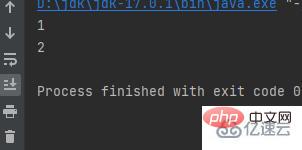
The third formatted outputResult:The meaning of %d It is an int type variable, that is, replace the first %d with the value of w, and replace the second %d with the value of a
public class a { public static void main(String[] args) { int w = 1; int a = 2; System.out.printf("w=%d a=%d", w, a); }}

Branch statement
if else
if() The condition in the brackets returns true as long as it is correct, and false if it is wrong.else means otherwise
public class a { public static void main(String[] args) { if (1>2){ System.out.println("A"); }else { System.out.println("B"); } }}
Multiple judgments are as follows: If the first judgment is incorrect, the next judgment will be made. When the return value is true, it will be executed, otherwise else## will be executed.switch case default#
public class a { public static void main(String[] args) { if (1 > 2) { System.out.println("A"); } else if (1 > 0) { System.out.println("B"); } else { System.out.println("C"); } }}
#switch multi-branch switch statement
switch(w) w in brackets is the judgment parameter, and the number after case is A value that matches w. When the value of w matches the value after the case, the statement in the current case is executedbreak means to exit the current judgment, which means that there is no need to judge again later
default means the default value, when there is no match The default is thispublic class a { public static void main(String[] args) { int w=1; String wk = ""; switch (w) { case 2: wk = "星期一"; break; case 3: wk = "星期二"; break; case 4: wk = "星期三"; break; case 5: wk = "星期四"; break; case 6: wk = "星期五"; break; case 7: wk = "星期六"; break; default: wk = "星期日"; break; } System.out.println(wk); }}result:
 Loop statement
Loop statement
for
for ( int i = 0; i 5
public class a {
public static void main(String[] args) {
for (int i = 0; i < 5; i++) {
System.out.println(i);
}
}} Result:
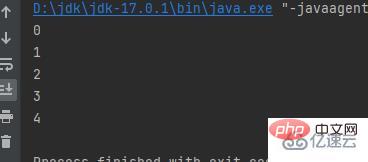 for in
for in
public class a {
public static void main(String[] args) {
int[] a = {1, 2, 3, 4, 5};
for (int i : a) {
System.out.println(i);
}
}}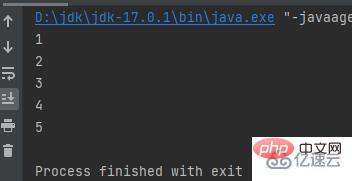 while do while
while do while
while(condition){ }
- Execute the statement if the condition is met, exit if not.
public class a { public static void main(String[] args) { int i = 0; while (i < 5) { i++; System.out.println(i); } }}Result:
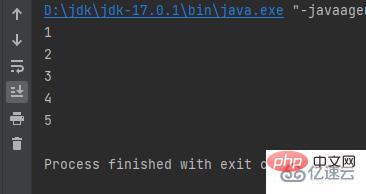
Different from while, do while is executed once Then judgeThe output is executed first and then judged. Therefore, the condition iThe result is:
public class a { public static void main(String[] args) { int i = 0; do { i++; System.out.println(i); } while (i < 0); }}
 break continue
break continue
break;Skip this time when i is divisible by 2 , proceed to the next cycle. When i is greater than 10, the loop ends.Terminate the current loop statement continue;
End this loop and immediately prepare to start the next loopint i = 0;while (++i < 20) { if (i % 2 == 0) continue; System.out.println(i); if (i > 10) break;}
The above is the detailed content of JAVA process control is implemented in this way. For more information, please follow other related articles on the PHP Chinese website!

